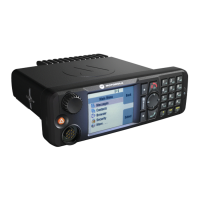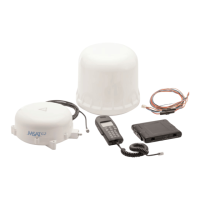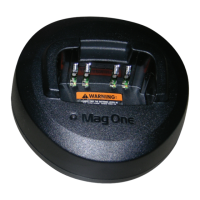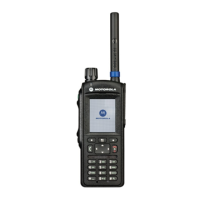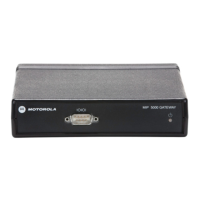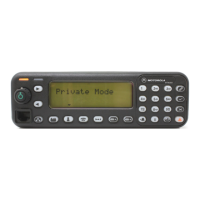68P81083C20-D December 6, 2004
Controller Section Theory of Operation: Audio and Signalling Circuits 7-23
Since sub-audible signalling is summed with voice information on transmit, it must be separated from
the voice information before processing. Any sub-audible signalling enters the ASFIC from the ZIF at
PL IN U0200-J7. Once inside it goes through the PL/DPL path. The signal first passes through one of
2 low pass filters, either PL low pass filter or DPL/LST low pass filter. Either signal is then filtered and
goes through a limiter and exits the ASFIC as PL RX (U0200-A4). At this point the signal will appear
as a square wave version of the sub-audible signal which the radio received. This signal then goes to
the SLIC (U0104-E7).The SLIC must be polled periodically by the microprocessor to determine the
state of bit 0 for port L (see SLIC description block for details). The microprocessor will then use that
information to decode the signal.
Note these paths are somewhat different for radios using Hear Clear (See Hear Clear description
block for details).
Audio Amplification Speaker (+) / (-) (Refer to schematic page 10-33 for reference)
The output of the ASFIC’s digital volume pot, U0204-J4 is routed through a voltage divider formed by
R0234 and R0235 to set the correct input level to the audio PA (U0203). This is necessary because
the gain of the audio PA is 46 dB, and the ASFIC output is capable of overdriving the PA unless the
maximum volume is limited.
The audio then passes through C0240 which provides AC coupling and low frequency roll-off. C0242
provides high frequency roll-off as the audio signal is routed to pins 1 and 9 of the audio power
amplifier U0203.
The audio power amplifier has one inverted and one non-inverted output that produces the
differential audio output SPK+/SPK- (U0203-4/6). The inputs for each of these amplifiers are pins 1
and 9 respectively; these inputs are both tied to the received audio. The audio PA’s DC biases are
not activated until the audio PA is enabled at pin 8.
The audio PA is enabled via AUPA EN signal from the SLIC (U0104-F7). When the base of Q0200 is
low, the transistor is off and U0203-8 is high, using pull up resistor R0236 — Audio PA is ON. The
U0203-8 must be above 8.5 VDC to properly enable the device. If the voltage is between 3.3 and
6.4 V, the device will be active but has its input (U0203-1/9) off. This a mute condition which is not
employed in this radio design. R0202 ensures that the base of Q0202 is high on power up.
Otherwise there may be an audio pop due to R0236 pulling U0203-8 high before the software can
switch on Q0200.
The SPK+ and SPK- outputs of the audio PA have a DC bias which varies proportionately with A+
CONT (U0200-7). A+ CONT of 11 V yields a DC offset of 5 V, and A+ CONT of 17 V yields a DC
offset of 8.5 V. If either of these lines is shorted to ground, it is possible that the audio PA will be
damaged. SPK+ and SPK- are routed to the accessory connector (J0403-1 and 3). Only the SPK- is
routed to the control head. For either, the internal (control head) speaker or the external speaker
connected to the remote control head cable, to be enabled, a jumper must be placed on the
accessory connector between pins 1 and 2; this connects SPK+ to the control head’s INT SPK+.
Handset Audio (Refer to schematic page 10-33 for reference)
Certain hand held accessories have a speaker within them which require a different voltage level
than that provided by U0203. For those devices RX HI is available at J0405-8.
The received audio from the output of the ASFIC’s digital volume attenuator is also routed to U0202
pin 6 where it is amplified 15 dB; this is set by the 10k/68k combination of R0238 and R0237. This
signal is routed directly from the output of the op amp U202 pin 7 to J0405-8. The control head sends
this signal directly out to the microphone jack. The maximum value of this output is 6.6 Vpp. If the
handset is Off-Hook, the audio PA (U0203) is disabled. C0434 is for RF bypass and VR0418 is for
static protection.
